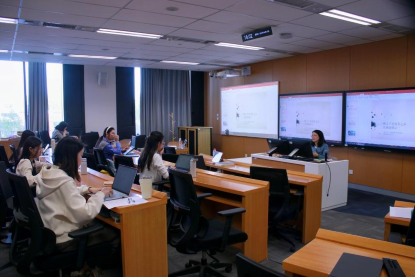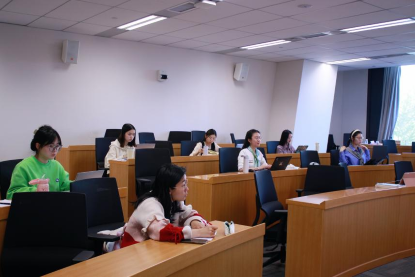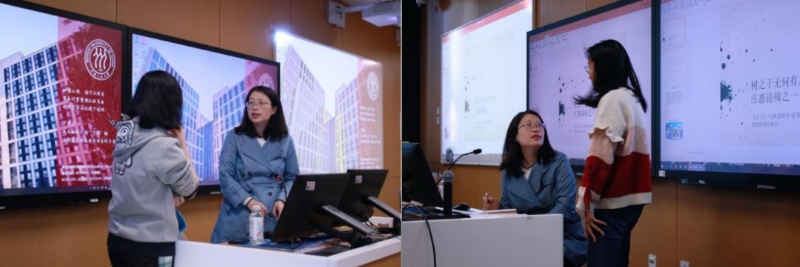On the afternoon of April 16th at 4:00 p.m., the lecture themed by “The Tree in the Land of Non-Being: A Discussion of the Debate Between Zhuang Zi and Hui Zi” was held in Room 303 of Lide Building. This event is part of reading program to Zhuang Zi and Mythological Philosophy.

Ms. Rao Jing briefly reviewed the first two parts of The Free and Easy Wandering - “The Myth of Kunpeng” and “Xu You Escapes from Emperor Yao”, and then introduced the life of Hui Zi and the friendship between Zhuang Zi and Hui Zi. She began with Hui Zi’s ten debate propositions called “Ten Things in History” and led audience to understand the historical background of Zhuang Zi and Hui Zi’s debates, as well as the philosophical characteristics of Hui Zi’s thinking, which were described as “contradictory ideas, divergent theories, and inconclusive language”.

This lecture begins with the debate on the usefulness and uselessness of Zhuang Zi and Hui Zi in The Free and Easy Wandering. Hui Zi regards “seeds of bottle gourd” and “large tree” as useless from the perspective of practicality. However, Zhuang Zi believed that the seeds of a large bottle gourd could float on the river and become a large wine jar, and that a large tree can be planted in the land of non-being and vast wilderness, so that people can wander aimlessly by its side and live freely under its shade. Both the “seeds of the large bottle gourd” and the “large tree” reflect Zhuang Zi’s attitude towards life. He transformed the strong social responsibility of scholars who stepped onto the historical stage during the period of the “Hundred Schools of Thought” into an internal transformation, using the great usefulness of uselessness and turning towards the natural foundation of the study of life. Ms. Rao analyzed in detail the fable of the “Sheli tree” in The World on Earth. The imagery of “useful wood” and “useless wood” is a further deepening of the debate between usefulness and uselessness. Useful wood is cut down prematurely by axes due to its usefulness, while useless wood exists a long life due to its uselessness. Zhuang Zi conveys the idea of “using the uselessness to protect itself” through the mouth of the “Sheli tree”, in short, the great usefulness of uselessness is to live life to the fullest and connect with the universe.
Ms. Rao specifically pointed out that the prototype of the tree in the “Tree in the Land of Non-Being” that connects heaven and earth is the Jianmu tree in the Classic of Mountains and Seas. After the Jianmu tree was destroyed, people lost the freedom to enter heaven and earth. Zhuang Zi creatively transformed the ancient divine tree, which had a communal and religious nature, into a source of human culture for the cultivation of a gentleman’s character and life, forming the foundation of the hierarchical levels of the character of the sage, divine and perfect man. Since the 20th century, myth criticism has been closely linked to psychology. After the demystification, only through psychoanalysis can sacred objects be understood. In this regard, the great transformative potential of the “Tree of Life” lies in its useless use.

At the end of the lecture, Ms. Rao chose Guo Xiang’s annotation as the conclusion: “For a king who lacks talent, the officials handle state affairs. Wise people were appointed to supervise, intelligent people were appointed to listen, knowledgeable people were appointed to plan, and brave people were appointed to protect. This was because the king himself lacked the ability to manage the country, so he needed to find stronger people to assist him. However, if the talents of the officials were fully utilized, even if the king was not capable, good management could still be achieved. Therefore, people like to promote talents, who can adapt to everything without being harmed.” Ms. Rao also quoted chapter 25 of the Tao Te Ching, which says “Therefore, there are four things that are great in the universe. The Tao is great. Heaven is great. Earth is great. The king and his people are also great. In this regard, and the king and his people are one of the four greats.” These two paragraphs further explain the “uselessness and incompetence” of the “Tongtian” tree. Literally, the king is an image of a ruler and leader; Moreover, the king is also the embodiment of the three elements of heaven, earth, and humanity, and follows the principle of “one consistent with three”. Each person is their own master and can cultivate a “Tongtian” tree within their own body and mind, experiencing a sense of carefree freedom.

Ms. Rao’s in-depth and easy-to-understand explanations led everyone to appreciate the wonderful content of Zhuang Zi’s arguments and stimulated everyone’s interest in reading the text of Zhuangzi. During the questioning and interaction session, the students actively spoke out. For the questions that everyone was interested in, Ms. Rao engaged in lively discussions with everyone, and everyone expressed that they benefited greatly.


